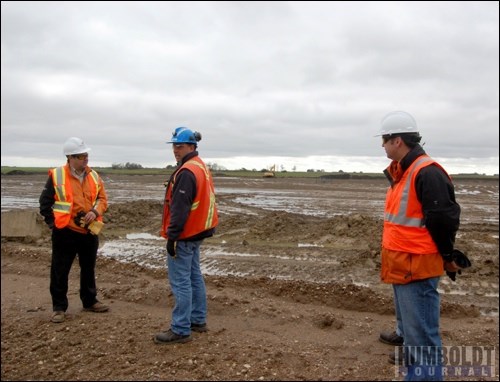It's an unprepossessing sight at the moment. The muddy, wet patch of gravel and dirt with a scattering of heavy equipment and temporary trailers south of LeRoy hardly seems like what could be the start of a major expansion to the mining industry in the province.
The shaft site of the proposed Jansen project, a multi-million dollar possible potash mine started by BHP Billiton, a giant international mining company headquartered in Australia, is, at present, hardly the stuff to inspire dreams of prosperity.
On September 7, BHP's Derek Chubb, manager of sustainability and external affairs, and Graham Kerr, president of diamonds and specialty products with BHP, were at the site to host a tour and answer questions about the proposed project, as well as plead their case for BHP's recent takeover bid of PotashCorp.
The wet weather has delayed work on the proposed mine site, which includes approximately 70 quarter-sections of farmland in the RMs of Prairie Rose and LeRoy.
Work continues, though, with trucks hauling gravel from Watrous in hour and a half round trips to build the pads for the drills which will start the ground-freezing process this fall. As well, crews from SaskPower and Graham Construction are across the road from the shaft site, preparing the temporary power plant which will support the ground freezing project and provide power for the construction phase of the mine.
In the ground freezing portion, approximately 100 holes will be drilled for calcium chloride brine, used to chill the ground as it runs through pipes and back through freeze plants. The shafts will be between 525 metres and 720 metres deep for the freezing, while the production and service shafts will be approximately one kilometre deep. It will take close to 300 days to complete the ground freezing, Chubb said.
The total gravel haul for the site to prepare the drill pads is 140,000 tonnes of gravel. Right now, there are 24 trucks hauling gravel every day hitting a high of 108 truckloads delivered in one day.
When the mine is up and running, there will be two large processing buildings, warehouses, and offices, along with runoff ponds and tailings mounds on the site, explained Chubb.
The first ore from the mine is projected to start coming out in 2015, but there are several steps that need to be completed before the mine is approved, he noted. BHP is currently working on the Environment Impact Statement (EIS) which will be submitted to the provincial government later this fall. The company is hoping that approval will be forthcoming in 2011, which will allow them to start construction soon after.
While the mine hasn't yet been approved, controversy over whether the project would continue if BHP's bid for PotashCorp was successful is unfounded, said Kerr.
"We've invested over $400 million in the site to date," explained Kerr. "We need the current mines, the expansion that has been added to those mines, and new mines to meet the growing demand (for potash)."
According to Kerr, there has been some overcapacity in potash in Saskatchewan, but in the last decade, demand for the product has been growing by 3.1 per cent a year, thanks to the need for more food production in the developing world, especially Brazil, China, and India.
Potash is used primarily in the production of fertilizers.
Buying PotashCorp would just allow BHP to get into the potash industry quicker, he explained.
BHP is planning for eight million tonnes of potash to be mined every year, once the Jansen mine reaches full capacity, Kerr said. But it will take eight to 10 years after the first ore is taken out to reach that target.
Kerr isn't worried by rumours of another bid materializing for PotashCorp, as there are always lots of rumours floating about.
"Right now, there is one bid on the table," he said. "PotashCorp is a great company. It does a lot of things well, but they need greenfields."
Greenfields is the term for new mines, as opposed to mines already in operation. No new potash mines have been built in the province since the 1960s.
Overall, BHP is positive potash markets will rebound.
"The global recession has had an impact on most industries and they need time to bounce back, but we see potash as a growth industry in the long term," he stated. "We have multiple commodities, so we can ride out the ups and downs in one."




